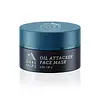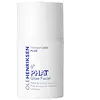What's inside
What's inside
 Key Ingredients
Key Ingredients

 Benefits
Benefits

 Concerns
Concerns

 Ingredients Side-by-side
Ingredients Side-by-side

Water
Skin ConditioningKaolin
AbrasiveGlycerin
HumectantCaprylic/Capric Triglyceride
MaskingGlyceryl Stearate Se
EmulsifyingPropanediol
SolventMyrica Pubescens Fruit Wax
Skin ConditioningSea Silt
Skin ConditioningStearic Acid
CleansingCI 77007
Cosmetic ColorantPerlite
AbsorbentCI 77499
Cosmetic ColorantNiacinamide
SmoothingCarbomer
Emulsion StabilisingPhenoxyethanol
PreservativeCaprylyl Glycol
EmollientSodium Hydroxide
BufferingParfum
MaskingAscorbyl Glucoside
AntioxidantPotassium Sorbate
PreservativeTocopheryl Acetate
AntioxidantMenthol
MaskingHexylene Glycol
EmulsifyingCladonia Rangiferina Extract
Skin ConditioningPlankton Extract
Skin ConditioningVaccinium Angustifolium Fruit Extract
Skin ProtectingMenthyl Lactate
MaskingWater, Kaolin, Glycerin, Caprylic/Capric Triglyceride, Glyceryl Stearate Se, Propanediol, Myrica Pubescens Fruit Wax, Sea Silt, Stearic Acid, CI 77007, Perlite, CI 77499, Niacinamide, Carbomer, Phenoxyethanol, Caprylyl Glycol, Sodium Hydroxide, Parfum, Ascorbyl Glucoside, Potassium Sorbate, Tocopheryl Acetate, Menthol, Hexylene Glycol, Cladonia Rangiferina Extract, Plankton Extract, Vaccinium Angustifolium Fruit Extract, Menthyl Lactate
Water
Skin ConditioningGlycerin
HumectantKaolin
AbrasiveGluconolactone
Skin ConditioningGluconic Acid
Polyglyceryl-10 Stearate
Skin ConditioningPropanediol
SolventBentonite
AbsorbentCetearyl Alcohol
EmollientSalvia Hispanica Seed Oil
MoisturisingBetula Alba Juice
AstringentGlyceryl Stearate
EmollientPolyacrylate-13
Sodium Hydroxide
BufferingParfum
MaskingPullulan
Polyisobutene
Phenoxyethanol
PreservativeCaprylyl Glycol
EmollientXanthan Gum
EmulsifyingPotassium Sorbate
PreservativePolysorbate 20
EmulsifyingHexylene Glycol
EmulsifyingSorbitan Isostearate
EmulsifyingTocopherol
AntioxidantBiotin
AntiseborrhoeicHyaluronic Acid
HumectantNiacinamide
SmoothingPanthenol
Skin ConditioningChamomilla Recutita Flower Extract
MaskingCitrus Limon Fruit Extract
MaskingGlycyrrhiza Glabra Root Extract
BleachingSaccharum Officinarum Extract
MoisturisingSantalum Album Extract
CleansingEriophorum Spissum Flower/Stem Extract
Skin ConditioningChlorphenesin
AntimicrobialLeuconostoc/Radish Root Ferment Filtrate
AntimicrobialSorbic Acid
PreservativeIron Oxides
Citral
PerfumingLimonene
PerfumingLinalool
PerfumingWater, Glycerin, Kaolin, Gluconolactone, Gluconic Acid, Polyglyceryl-10 Stearate, Propanediol, Bentonite, Cetearyl Alcohol, Salvia Hispanica Seed Oil, Betula Alba Juice, Glyceryl Stearate, Polyacrylate-13, Sodium Hydroxide, Parfum, Pullulan, Polyisobutene, Phenoxyethanol, Caprylyl Glycol, Xanthan Gum, Potassium Sorbate, Polysorbate 20, Hexylene Glycol, Sorbitan Isostearate, Tocopherol, Biotin, Hyaluronic Acid, Niacinamide, Panthenol, Chamomilla Recutita Flower Extract, Citrus Limon Fruit Extract, Glycyrrhiza Glabra Root Extract, Saccharum Officinarum Extract, Santalum Album Extract, Eriophorum Spissum Flower/Stem Extract, Chlorphenesin, Leuconostoc/Radish Root Ferment Filtrate, Sorbic Acid, Iron Oxides, Citral, Limonene, Linalool
 Reviews
Reviews

Ingredients Explained
These ingredients are found in both products.
Ingredients higher up in an ingredient list are typically present in a larger amount.
Caprylyl Glycol is a humectant and emollient, meaning it attracts and preserves moisture.
It is a common ingredient in many products, especially those designed to hydrate skin. The primary benefits are retaining moisture, skin softening, and promoting a healthy skin barrier.
Though Caprylyl Glycol is an alcohol derived from fatty acids, it is not the kind that can dry out skin.
This ingredient is also used as a preservative to extend the life of products. It has slight antimicrobial properties.
Learn more about Caprylyl GlycolGlycerin is already naturally found in your skin. It helps moisturize and protect your skin.
A study from 2016 found glycerin to be more effective as a humectant than AHAs and hyaluronic acid.
As a humectant, it helps the skin stay hydrated by pulling moisture to your skin. The low molecular weight of glycerin allows it to pull moisture into the deeper layers of your skin.
Hydrated skin improves your skin barrier; Your skin barrier helps protect against irritants and bacteria.
Glycerin has also been found to have antimicrobial and antiviral properties. Due to these properties, glycerin is often used in wound and burn treatments.
In cosmetics, glycerin is usually derived from plants such as soybean or palm. However, it can also be sourced from animals, such as tallow or animal fat.
This ingredient is organic, colorless, odorless, and non-toxic.
Glycerin is the name for this ingredient in American English. British English uses Glycerol/Glycerine.
Learn more about GlycerinHexylene Glycol is a surfactant. Glycols are a class of alcohols. Hexylene Glycol is a surfactant and emulsifier.
As a surfactant, Hexylene Glycol helps gather dirt and oil on your skin to be washed away.
As an emulsifier, Hexylene Glycol helps keep water and oil together. This prevents them from separating in a product. Hexylene Glycol also thins out the texture of a product by lessening viscosity.
Hexylene Glycol has a small molecular weight.
Learn more about Hexylene GlycolKaolin is a clay. It is used for oil control and to help minimize pores. Like other clays, kaolin has the ability to absorb excess sebum or oil. This can help clean out pores and mattify the skin.
Some types of kaolin may have exfoliating properties. When water is added to kaolin, it becomes a paste with small abrasive particles.
Most kaolin is a white color, but may be pink/orange/red depending on where it comes from.
The name 'kaolin' comes from a Chinese village named 'Gaoling'. Kaolin clay comes from rocks rich in kaolinite. Kaolinite, the mineral, has a silicate layered structure. Kaolinite is formed from chemical weathering of aluminum siilicate minerals.
Besides skincare, kaolin is commonly used to make glossy paper, in ceramics, toothpaste, and as medicine to soothe stomach issues.
Learn more about KaolinNiacinamide is a multitasking form of vitamin B3 that strengthens the skin barrier, reduces pores and dark spots, regulates oil, and improves signs of aging.
And the best part? It's gentle and well-tolerated by most skin types, including sensitive and reactive skin.
You might have heard of "niacin flush", or the reddening of skin that causes itchiness. Niacinamide has not been found to cause this.
In very rare cases, some individuals may not be able to tolerate niacinamide at all or experience an allergic reaction to it.
If you are experiencing flaking, irritation, and dryness with this ingredient, be sure to double check all your products as this ingredient can be found in all categories of skincare.
When incorporating niacinamide into your routine, look out for concentration amounts. Typically, 5% niacinamide provides benefits such as fading dark spots. However, if you have sensitive skin, it is better to begin with a smaller concentration.
When you apply niacinamide to your skin, your body converts it into nicotinamide adenine dinucleotide (NAD). NAD is an essential coenzyme that is already found in your cells as "fuel" and powers countless biological processes.
In your skin, NAD helps repair cell damage, produce new healthy cells, support collagen production, strengthen the skin barrier, and fight environmental stressors (like UV and pollution).
Our natural NAD levels start to decline with age, leading to slower skin repair, visible aging, and a weaker skin barrier. By providing your skin niacinamide, you're recharging your skin's NAD levels. This leads to stronger, healthier, and younger looking skin.
Another name for vitamin B3 is nicotinamide. This vitamin is water-soluble and our bodies don't store it. We obtain Vitamin B3 from either food or skincare. Meat, fish, wheat, yeast, and leafy greens contain vitamin B3.
The type of niacinamide used in skincare is synthetically created.
Learn more about NiacinamideParfum is a catch-all term for an ingredient or more that is used to give a scent to products.
Also called "fragrance", this ingredient can be a blend of hundreds of chemicals or plant oils. This means every product with "fragrance" or "parfum" in the ingredients list is a different mixture.
For instance, Habanolide is a proprietary trade name for a specific aroma chemical. When used as a fragrance ingredient in cosmetics, most aroma chemicals fall under the broad labeling category of “FRAGRANCE” or “PARFUM” according to EU and US regulations.
The term 'parfum' or 'fragrance' is not regulated in many countries. In many cases, it is up to the brand to define this term.
For instance, many brands choose to label themselves as "fragrance-free" because they are not using synthetic fragrances. However, their products may still contain ingredients such as essential oils that are considered a fragrance by INCI standards.
One example is Calendula flower extract. Calendula is an essential oil that still imparts a scent or 'fragrance'.
Depending on the blend, the ingredients in the mixture can cause allergies and sensitivities on the skin. Some ingredients that are known EU allergens include linalool and citronellol.
Parfum can also be used to mask or cover an unpleasant scent.
The bottom line is: not all fragrances/parfum/ingredients are created equally. If you are worried about fragrances, we recommend taking a closer look at an ingredient. And of course, we always recommend speaking with a professional.
Learn more about ParfumPhenoxyethanol is a preservative that has germicide, antimicrobial, and aromatic properties. Studies show that phenoxyethanol can prevent microbial growth. By itself, it has a scent that is similar to that of a rose.
It's often used in formulations along with Caprylyl Glycol to preserve the shelf life of products.
Potassium Sorbate is a preservative used to prevent yeast and mold in products. It is commonly found in both cosmetic and food products.
This ingredient comes from potassium salt derived from sorbic acid. Sorbic acid is a natural antibiotic and effective against fungus.
Both potassium sorbate and sorbic acid can be found in baked goods, cheeses, dried meats, dried fruit, ice cream, pickles, wine, yogurt, and more.
You'll often find this ingredient used with other preservatives.
Learn more about Potassium SorbatePropanediol is an all-star ingredient. It softens, hydrates, and smooths the skin.
It’s often used to:
Propanediol is not likely to cause sensitivity and considered safe to use. It is derived from corn or petroleum with a clear color and no scent.
Learn more about PropanediolSodium Hydroxide is also known as lye or caustic soda. It is used to adjust the pH of products; many ingredients require a specific pH to be effective.
In small amounts, sodium hydroxide is considered safe to use. However, large amounts may cause chemical burns due to its high alkaline.
Your skin has a natural pH and acid mantle. This acid mantle helps prevent harmful bacteria from breaking through. The acid mantle also helps keep your skin hydrated.
"Alkaline" refers to a high pH level. A low pH level would be considered acidic.
Learn more about Sodium HydroxideWater. It's the most common cosmetic ingredient of all. You'll usually see it at the top of ingredient lists, meaning that it makes up the largest part of the product.
So why is it so popular? Water most often acts as a solvent - this means that it helps dissolve other ingredients into the formulation.
You'll also recognize water as that liquid we all need to stay alive. If you see this, drink a glass of water. Stay hydrated!
Learn more about Water